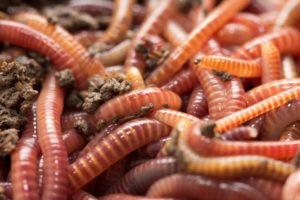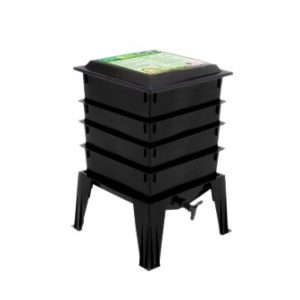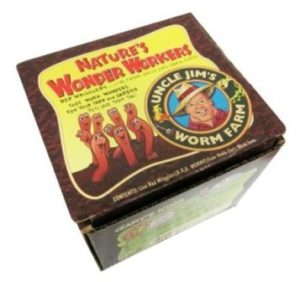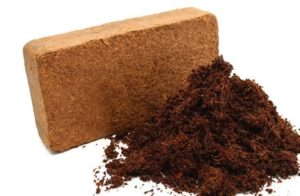Worm Composting is a very different way to produce rich garden Compost from your kitchen scraps. Unlike Compost Bins and Compost Tumblers, compost from a worm farm does not rely on internal heat to turn your scraps into rich new soil.
In a worm farm, as the name suggests, it is the special (Red) Composting Worms that do the work.

Worm composting does not involve regular garden worms. In fact, Compost worms will probably not survive if accidentally removed from your worm farm trays, and added to your garden beds with the castings. Composting worms live off the bacteria created by the degrading scraps.
Composting worms cannot tolerate heat or sunlight, so keep this in mind, and place your worm farm in a shady position. It also helps to place a moist hessian sack or layers of moist cardboard on top of the scraps in your top tray, to keep worms cool.
Your Compost worms will rapidly burrow down to escape any sunlight. This is very helpful when it comes to harvesting worm castings from your trays. As the worms burrow, you can safely remove the castings without discarding the worms themselves.
What makes a good Worm Farm.

The first thing you will notice is that most worm farms are Black in color. This is due to the fact that Composting Worms actively move away from light, even light colors. We want the worms to progressively move from one full tray, up into a new one placed above it, so dark works best.
If at anytime you find your worms moving down into the worm tea reservoir at the bottom of your stack, simply remove the base and paint the inside of it white. I did, and it worked perfectly, worms migrated up into the feed trays from then on.
Secondly, the Lid should be solid, no holes to allow light in. The individual trays should stack together neatly, and easily. The base of the trays will be a network of small holes to allow your worms to move up from below and into each tray as it is added.
The reservoir at the bottom should have a spigot in place to allow you to harvest the fluid if you choose, or to allow it to naturally drain if you are not using it. The legs of your system should leave the base of the Worm Tea reservoir high enough from the ground that you can harvest the fluid easily.
Once your worm farm arrives, you will also need to purchase live compost worms.
There are numerous types of Composting worms available. Whichever you choose, you buy these by the thousands. You could start with as few as 500 worms but it slows the development down The more worms you buy up front the faster your farm develops.
When ordering, also buy some Coco Fiber bedding. This is reduced to a saw dust like consistency for your worms to nestle into on arrival

You can order all these items, the worm farm, live worms and Coco Fiber here so it arrives together from Amazon
Let’s start Worm Composting
To start your worm composting eco-system, all you will need is the Worm Farm base, with one tray on top and the lid Place the Coco Fiber, (complete with worms), from the package they arrive in and place this into the Tray.
From there, simply add your kitchen scraps, torn up cardboard etc day by day into the Tray containing the worms. You don’t need to add moisture at any time. The worms will start breaking down the Fiber and the scraps.
Just keep adding scraps until the tray is full. By that I mean the broken down material in the first tray is high enough that you can add a second tray on top, and the bottom of the second tray will be resting on the material contained in the first.
Compost worms are amazing things, but one thing they cannot do is Jump. They need to be able to move from the lower tray to the upper tray as the food source in the bottom is exhausted. Once in place, new, fresh food is added to the top tray and worms will start to move up.
You can continue adding trays to the top in this way. After a few months of worm composting, you will start to harvest completed compost by lifting out the bottom tray. Completed Worm Castings are black in color and will contain little or no food remanents. As your worms multiply, subsequent trays will be converted more quickly.
Feeding your worms
When starting out you are only going to have a relatively small number of worms. Don’t overdo the feeding in the early stages. Just add a small amount each day, and gauge how much is being consumed as you go forward. It will not help to overwhelm the worms with more than they can handle.
The smaller the material you add to your trays, the faster the worms will be able to convert it. So, either chop it all up nice and small, or you can buy a Green Cycler Kitchen Shredder. This will do a great job of making your kitchen scraps “Worm Friendly”
Composting Guidelines
Some worm farms come with detailed user guides on successfully composting with worms. Others provide access to online digital guides. Be sure to follow yours closely. Once you get started, the worm numbers in your system will grow continuously. As the numbers increase the volume of material consumed and the speed will increase as well.
